| |
|||||||||
| |
|
|
|
|
|
|
|
||
| Home | About | Literature | Site Map | MSDS | Contact | Engineers | Shows | Links | Samples | RFQ | Catalog Numbers |
SUMMARY: A novel system for sealing air leaks in pressurized cable is described. American Polywater's AirRepair® process is fast, simple, and safe. The new sealant will seal hard-to-reach areas such as joints and "crotches." The AirRepair® system is sold as a convenient kit.
BACKGROUND: Air-pressurized cables are abundant throughout most major urban areas. Until the invention and availability of polyethylene, nearly all cables were jacketed with lead. The earliest transatlantic cables were lead jacketed with oiled paper as the insulation. Splices were made by wrapping the junction area with a sheet of lead, then welding with a bucket of molten lead and a brush, or a torch and stick of lead solder. This was the only technology available to telephone companies before the advent of polyethylene jacketed materials in the 1950's. Polyethylene cables installed today are more flexible and durable than lead. A high percentage of phone cables in the ground today are air-pressurized, and still function as long as water is kept out.
Water in a phone cable is highly destructive. To prevent water ingress, dry compressed air is fed into the cable network at a constant pressure of 3 to 10 psi. When leaks develop, air blows out, preventing water from coming in. But leaks must eventually be sealed. Effective methods for repairing both lead and polyethylene cables are needed.
PRESSURE LEAKS: Leaks in lead cables occur for a variety of reasons. Most common is metal fatigue. Flexing of joints develops small cracks where a splice has been sealed with hot lead. Flexing can be caused by workers moving the cable, walking on it, or by thermal expansion and contraction.
Lead used for cable jacketing is not pure lead; the most common alloys are lead/antimony and lead/silver. Lead antimony alloy, when stressed by severe flexing or compression, is subject to age embrittlement and rotted appearance. If cable is badly deformed when pulled in, or later subjected to crushing by a cave-in, that portion of cable will develop fractures and open along many transverse cracks. Occasionally, the cable's environment is corrosive and the jacket metal is eaten away, leaving air leaks.
Polyethylene jacketed cables are subject to cuts, punctures, and tears. Physical damage done by careless contractors with backhoes is also a factor.
The key to properly maintained air-pressurized cable systems is plugging the leaks fast enough to keep water out and compressors from over-working.
EXISTING METHODS: Until recently, methods available to telephone maintenance staffs to repair leaks were to "hot-wipe" with molten lead, enclose the entire leaking cable section with a plastic box, use shrink wrap systems, or replace the cable section with a new one.
Hot wiping is an effort to reweld using a bucket of molten lead carried down to the leak site and brushed onto the cable. This method is difficult and not always successful. Leaks usually occur at the joints made at an earlier hot wipe. It is often extremely difficult to clean the area well enough to allow adequate adherence. In many phone companies, hot lead and torches are prohibited in manholes, and few craftsmen currently have the training or experience to perform wipes in the field.
A splice case is a large two-sided enclosure that fits around the entire splice and is sealed with polymers and sealants. The cost is less than cable replacement, but still very high.
Shrink-wrap repair systems are limited to straight cable repairs. Large splices and those with two cables entering from one side cannot be repaired when the leak is in the "crotch" of the two cables.
First, the lead surface is cleaned with a shave hook, carding brush, or sandpaper. Then air pressure is released from that section of the cable by removing an air stem from the splice. A non-flash solvent wipe is then used to clean the splice surface and displace any water. Next, a two-part sealant material is mixed in a cup until it is of uniform color. The mixed sealant is applied over the leak area with plastic application tools. Normally, air pressure can be turned back on in about 15 minutes, after the sealant has cured. Similar steps are taken to repair plastic cables and end plates. Sandpaper (80 grit or lower) is used to roughen the surface to increase the adhesion. A shave hook should not be used in the preparation of the cable. For situations when the air cannot be released, a two-part putty is mixed together and held on the leak until cured. Then two-part sealer is applied over the putty. DURABILITY: SUMMARY: |
|---|
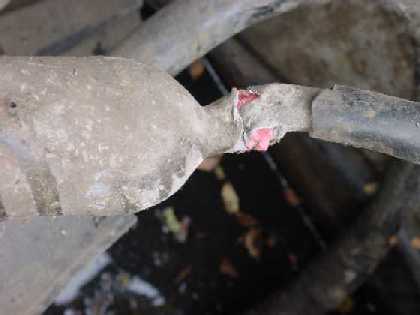 |
| A damaged cable. |
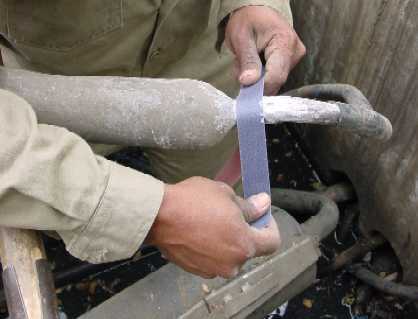
|
| Preparation of lead surface. |
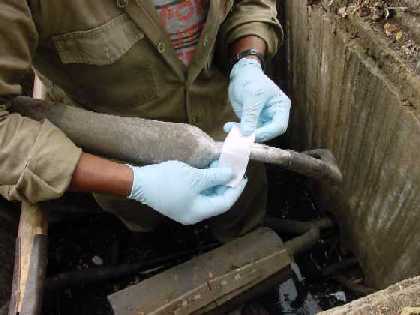 |
| Cleaning lead with TR-1™ non-flash solvent wipe. |
| |
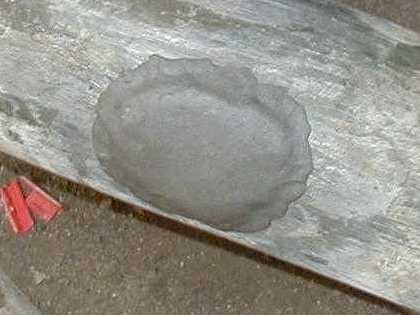 |
| Here, putty has been used to temporarily seal a leak. |
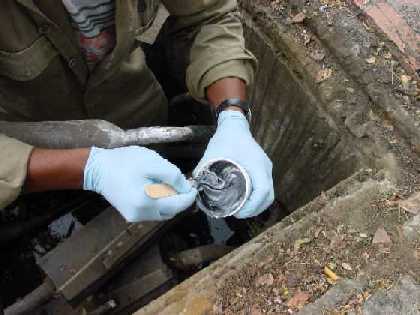 |
| Mixing 2-part sealer. |
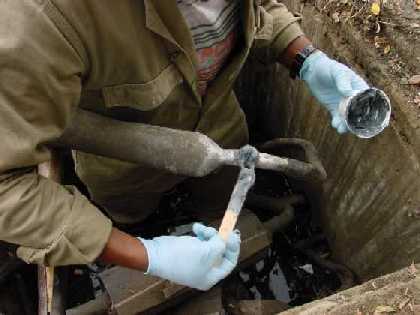 |
| Applying 2-part sealer to clean and dry surface. |
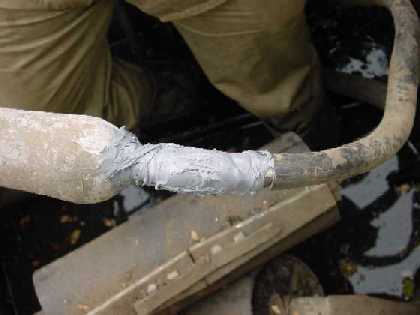 |
| Completed repair with AirRepair® leak repair system. |
Click here for more Application Photos
Click here to Add Your Name To Our Mail List
Click here to Request a Quote on This Product
Click here to view a Streaming Video clip on this product
Ask for Polywater® products by name at your local authorized distributor
Home |
About |
Site Map |
Literature |
Samples |
Links |
Reps |
Videos |
Pumps |
RFQ
Codes |
Engineering |
Shows |
Spotlight |
Newsletters |
MSDS |
Translations |
Contacts |
Jobs

11222 60th ST N | Stillwater, MN 55082-9310 USA
1-(651) 430-2270 (Voice) | 1-(651) 430-3634 (Fax)
1-(800) 328-9384 (Toll-Free US/Canada Only)
Copyright © 2001 - 2015 American Polywater Corporation | ![]() 6/5/15
6/5/15